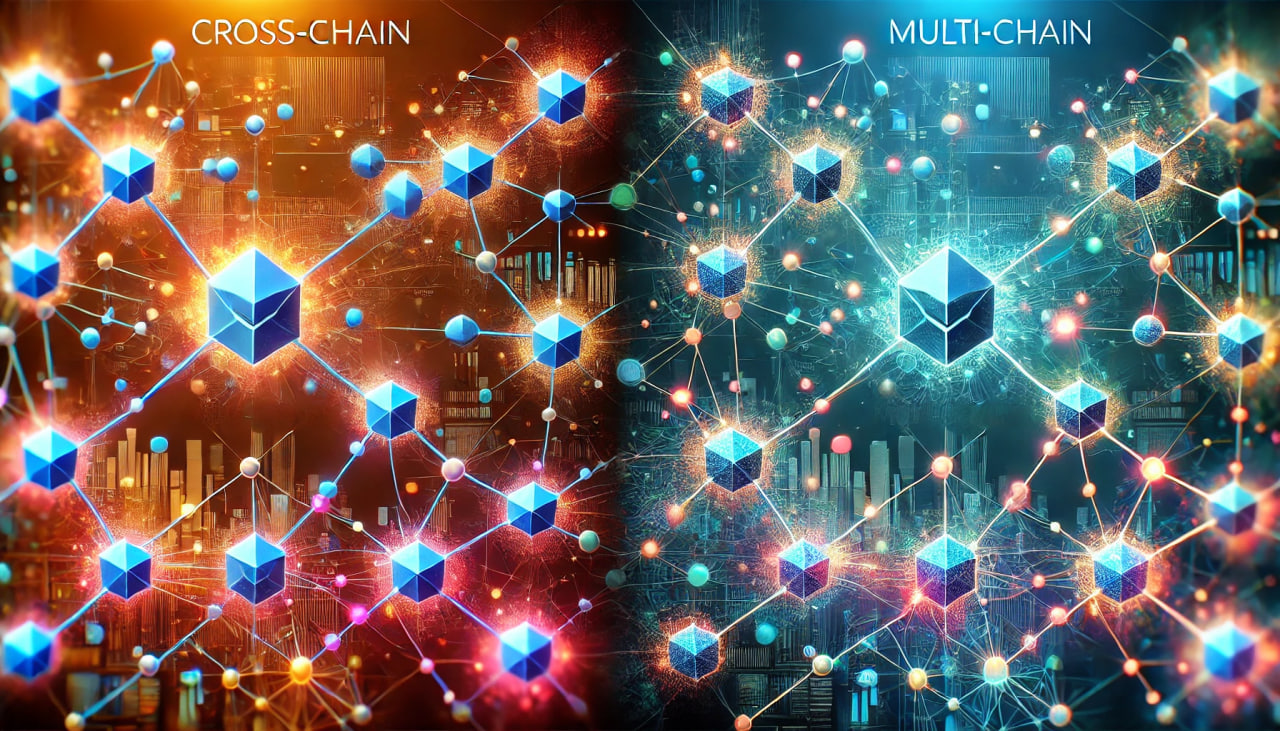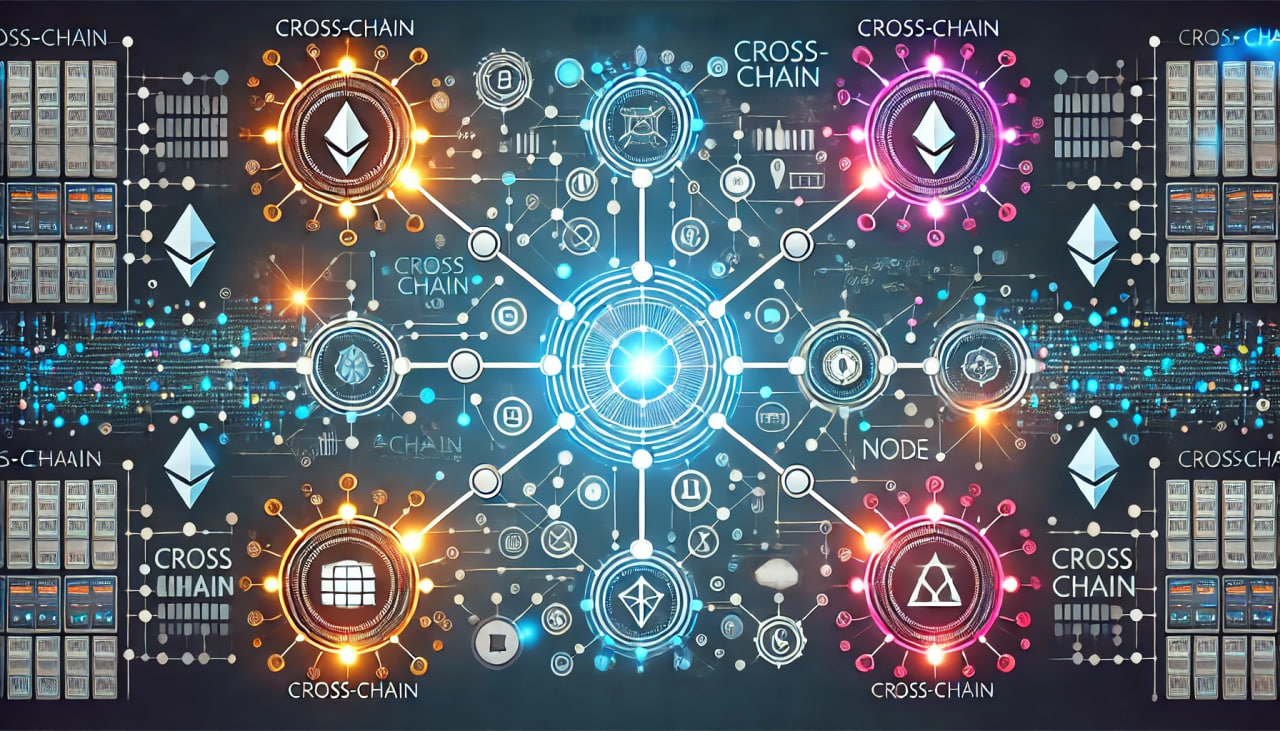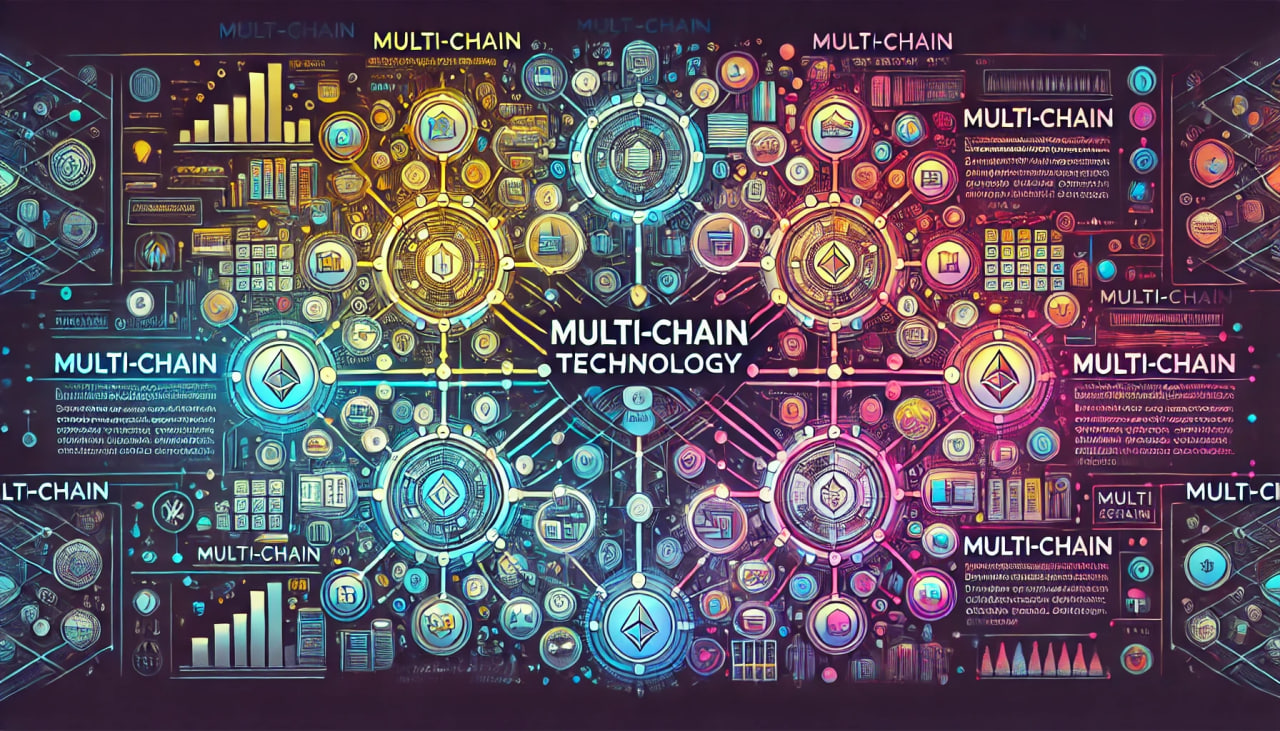Cross-chain and multichain are key concepts in the world of blockchain and cryptocurrency technologies, gaining increasing importance with the development of these technologies and the emergence of new cryptocurrencies. Cross-chain technology allows blockchains to exchange data and values using special protocols and bridges.
The main advantage of cross-chain lies in enhancing liquidity and improving interactions between different cryptocurrencies, despite the challenges of ensuring security and reliability. Multichain technology focuses on creating and managing multiple blockchains within a single platform, which enhances system flexibility and scalability. Combining different blockchains under one ecosystem simplifies management and integration, although setting up and maintaining such an infrastructure can be complex.

How Cross-chain Networks Work
Cross-chain blockchain networks represent an advanced architecture that facilitates the interaction of multiple independent blockchains in an interoperable environment. This architecture supports seamless exchange of assets and data between different networks, providing broader opportunities for users and developers. Cross-chain technology ensures secure and efficient transactions between decentralized applications (DApps) and smart contracts hosted on different blockchains, eliminating the need for a centralized intermediary and guaranteeing transaction security.
In natively built cross-chain applications, a single instance of a DApp can operate on various smart contracts deployed across multiple blockchains, removing the need to deploy separate instances in different networks.

This significantly simplifies the development and management process, as well as improves efficiency and coordination between different blockchains. Developers leverage cross-chain interoperability to coordinate specialized smart contracts across networks, enabling complex use cases with synchronized functionality, improving the overall user experience and expanding blockchain application possibilities.
Features of Cross-chain Networks:
- Interaction: Facilitates asset and data exchange between different blockchains.
- Transaction Security: Ensures transaction security without a centralized intermediary.
- Native Applications: A single instance of a DApp can operate on multiple blockchains.
- Development Simplification: Reduces the need to deploy separate application instances in different networks.
- Smart Contract Coordination: Allows coordinating the operation of specialized smart contracts across different networks.
- Complex Use Cases: Supports complex use cases with synchronized functionality.
Thus, cross-chain networks represent an important step forward in the evolution of blockchain technologies, providing more flexible and scalable solutions for various tasks and applications.
How Multichain Networks Work
The term "multichain blockchain" refers to a project that includes several interconnected blockchains operating within a single ecosystem. This architecture allows users of different chains to interact with each other without the need for asset exchanges. Technically, this is achieved by dividing the system into two layers: consensus and application.
A single consensus layer provides unified security for all chains within the network, ensuring a high degree of protection and reliability. The application layer, built on top of the consensus layer, is programmable. This allows each chain within the network to have unique features and use cases that meet specific needs and requirements.

This approach allows individual blockchains to coexist and interact, creating a more flexible and scalable infrastructure. Cosmos is an example of this architecture, supporting interoperability between blockchains while providing reliable security.
Features of Multichain Networks:
- Multitasking: Allows users to interact across different chains without the need for asset exchanges.
- Two-layer Architecture: The system is divided into a consensus layer and an application layer.
- Unified Security: The consensus layer provides common security for all chains within the network.
- Programmable Application Layer: The application layer allows each chain to have its unique features and use cases.
- Coexistence and Interaction: Enables individual blockchains to operate and interact within a single ecosystem.
- Example: Cosmos as an example of an architecture that supports interoperability and reliable security.
Thus, multichain networks represent an innovative approach to creating flexible and reliable blockchain ecosystems capable of meeting diverse needs and ensuring interaction between different chains.
Cross-chain vs. Multichain Comparison
Cross-chain and multichain solutions differ in scope, focus, and use cases.
Scope
The main difference between cross-chain and multichain networks lies in their architecture. Cross-chain solutions enable communication between independent blockchains. There are three mechanisms for implementing cross-chain solutions: lock and mint, burn and mint, and liquidity pools. Lock and mint involve locking tokens within smart contracts on the source chain and minting them on the destination chain. In the case of burn and mint, tokens are burned on the source chain, triggering the minting of equivalent value on the destination chain. Liquidity pools require the presence of the same tokens on both the source and destination blockchains, ensuring liquidity.
On the other hand, multichain architectures such as Cosmos and Polkadot involve managing multiple interconnected blockchains within a single network. Polkadot operates as a flexible multichain network with a relay chain and several parachains, each hosting different applications and customized features. The relay chain maintains network security and interoperability, while parachains use its security while maintaining some level of independent consensus.
Focus
Another major difference between the two concepts is their focus. Cross-chain technology prioritizes interoperability, facilitating communication between different blockchains. Multichain technology, on the other hand, focuses on adaptability and scalability, supporting an ecosystem where several chains operate in tandem within a single network.
Use Cases
Cross-chain technology enables the seamless transfer of digital assets between different blockchains, making decentralized finance (DeFi) a reality. In contrast, multichain technology is ideal for integrating multiple blockchains within a single ecosystem, which is useful for applications like supply chain management and complex gaming platforms.
Cross-chain and multichain technologies play important roles, providing different levels of interaction, scalability, and security. The table below presents the key differences between these technologies, helping to understand their unique features and applications.
| Parameter | Cross-chain | Multichain |
|---|---|---|
| Security | Distributed system with cryptographically secured data across multiple ledgers. | Permissioned networks restricting access to specific nodes and excluding external parties. |
| Scalability | Enhanced scalability through ledger communication. | Limited by the number of nodes that can join the network. |
| Speed | Fast transaction times due to rapid data flow across ledgers. | Possible delays due to the permissioned structure and the need for consensus among all participating nodes. |
| Cost-efficiency | Fees on each involved blockchain increase the overall cost. | Requires duplicating infrastructure for each chain, leading to higher initial and maintenance costs. |
| Interoperability | Facilitates seamless data and asset transfer between different networks. | Less flexibility, governed by a unique set of rules and protocols. |
Cross-chain solutions provide effective interoperability, allowing independent blockchains to interact and exchange assets, making them ideal for decentralized finance (DeFi) and other applications requiring cost-efficiency and low latency.
Multichain technologies, on the other hand, focus on creating flexible and scalable ecosystems where multiple interconnected blockchains can coexist and interact under a single network. This makes them ideal for complex applications such as supply chain management and gaming platforms, where security and integration are important.
Cross-chain and multichain architectures have been introduced as innovative solutions to ensure blockchain interoperability. Technological evolution and the emergence of more sophisticated solutions are likely to open up new possibilities and use cases for decentralized services and applications. Projects will choose between cross-chain and multichain architectures depending on the specific requirements of their applications and the required level of interoperability. Some projects may also combine these architectures, creating a more robust, flexible, and integrated blockchain ecosystem.



